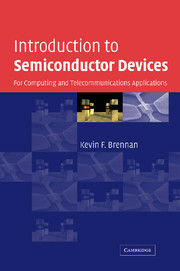Book contents
- Frontmatter
- Contents
- Preface
- List of physical constants
- List of materials parameters for important semiconductors, Si and GaAs
- 1 Semiconductor fundamentals
- 2 Carrier action
- 3 Junctions
- 4 Bipolar junction transistors
- 5 JFETs and MESFETs
- 6 Metal–insulator–semiconductor structures and MOSFETS
- 7 Short-channel effects and challenges to CMOS
- 8 Beyond CMOS
- 9 Telecommunications systems–an overview
- 10 Optoelectronic devices – emitters, light amplifiers, and detectors
- 11 Transistors for high frequency, high power amplifiers for wireless systems
- References
- Index
Preface
Published online by Cambridge University Press: 05 June 2012
- Frontmatter
- Contents
- Preface
- List of physical constants
- List of materials parameters for important semiconductors, Si and GaAs
- 1 Semiconductor fundamentals
- 2 Carrier action
- 3 Junctions
- 4 Bipolar junction transistors
- 5 JFETs and MESFETs
- 6 Metal–insulator–semiconductor structures and MOSFETS
- 7 Short-channel effects and challenges to CMOS
- 8 Beyond CMOS
- 9 Telecommunications systems–an overview
- 10 Optoelectronic devices – emitters, light amplifiers, and detectors
- 11 Transistors for high frequency, high power amplifiers for wireless systems
- References
- Index
Summary
At the time of this writing the microelectronics industry is poised at the threshold of a major turning point. For nearly fifty years, the industry has grown from the initial invention of the integrated circuit through the continued refinement and miniaturization of silicon based transistors. Along with the development of complementary metal oxide semiconductor circuitry, miniaturization of semiconductor devices created what has been called the information revolution. Each new generation of devices leads to improved performance of memory and microprocessor chips at ever reduced cost, thus fueling the expansion and development of computing technology. The growth rate in integrated circuit technology, a doubling in chip complexity every eighteen months or so, is known as Moore's First Law. Interestingly, the semiconductor industry has been able to keep pace with Moore's First Law and at times exceed it over the past forty years. However, now at the beginning of the twenty-first century doubts are being raised as to just how much longer the industry can follow Moore's First Law. There are many difficult challenges that confront CMOS technology as device dimensions scale down below 0.1 μm. Many people have predicted that several of these challenges will be so difficult and expensive to overcome that continued growth in CMOS development will be threatened. Further improvement in device technology will then require a disruptive, revolutionary technology.
One might first wonder why is it important to continue to improve microprocessor speed and memory storage much beyond current levels? Part of the answer to this question comes from the simultaneous development of the telecommunications industry.
- Type
- Chapter
- Information
- Introduction to Semiconductor DevicesFor Computing and Telecommunications Applications, pp. xi - xivPublisher: Cambridge University PressPrint publication year: 2005



